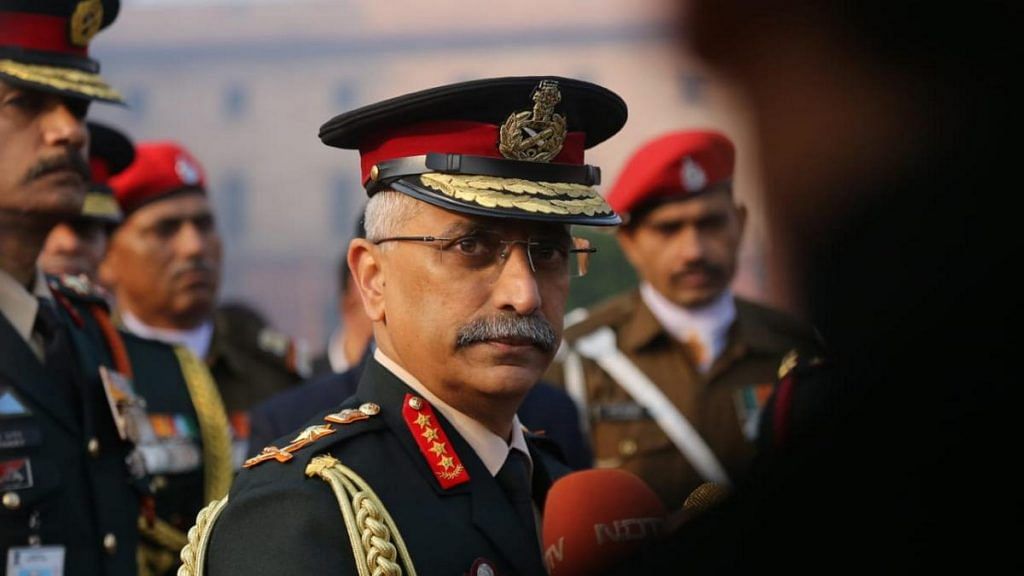New Delhi: The Army is recalibrating and refining its plans for “dynamic responses” below the threshold of all-out war, like the Balakot air strikes, against Pakistan and China, General M.M. Naravane said Wednesday.
Addressing a seminar organised by CLAWS, the Army’s think tank, Naravane spoke at length about the evolution of warcraft even as he emphasised the continued relevance of the ancient philosopher Chanakya’s famous treatise Arthashastra.
Among other things, he said the “military icons of the 20th century”, like tanks and fighter aircraft, were on their way out the same way the “Sony Walkman” was made redundant by newer technologies to hear music. The Army, he added, was looking at the possible induction of laser and directed-energy weapons.
Also Read: Army chief Naravane must hold back on China border issue till Tibet is settled
Playing the ‘escalatory game’
Apart from strengthening its conventional prowess, Naravane said, the Army was also focusing on “dynamic responses — actions below the threshold of all-out war”. The Balakot air strikes, according to him, were an example of playing the “escalatory game” with skill.
“We are refining our plans and capacities in this regard — both, along the western (Pakistan) and northern (China) borders. We are developing kinetic and non-kinetic responses to address the threat,” he added.
He said the world was witnessing a new phenomenon — the availability of sufficient space for demonstration of military prowess and ascendancy that doesn’t erupt in an all-out conflict.
“Supposed acts of war not leading to war,” he added. “The Houthi rebels’ attack on Riyadh airport and oil facilities in Saudi Arabia and closer home, the Balakot air strike, saw these short, intense, escalatory cycles of military activity, in full media glare, where sophisticated information narratives played an equally important role.”
For years, General Naravane said, it was believed that any crossing of the Line of Control by air would lead to a full-fledged war.
“Balakot demonstrated that if you play the escalatory game with skill, military ascendancy can be established in short cycles of conflict that do not necessarily lead to war,” he added.
The way forward — ‘Chanakya neeti’
The Army chief said “Chanakya neeti (policy)” provided new fodder for thought to effect change in contemporary thinking.
The Indian tradition of strategic thought, he added, was epitomised by works like the Arthashastra.
“Kautilya enunciated the sutra (manual) underlining the four forms of strategic means against enemies, in order of usage — ‘saam (conciliation)’, to advice and ask, ‘daam (gifts)’, to offer and buy, ‘dand (coercion)’, to punish, and ‘bhed (dissension)’, for exploiting secrets,” he said.
In the years since it was written, Naravane said, the Arthashastra had been variously adapted and repurposed.
“It has become a ‘how-to guide’ for ambitious enterprises. It could also become a touchstone for our foreign and strategic policymakers to devise a distinctively Indian view of international relations and statecraft,” he said.
Also Read: Army ready with roadmap for women officers’ permanent commission: Gen. Naravane
‘Tanks and fighters going out’
Speaking about modern warcraft, the Army chief hinted at a dwindling relevance of 20th-century “icons… like the main battle tanks and fighters”, which he said were on the way out.
Naravane noted that the last large tank battle, one where large armoured formations of two armies manoeuvred against each other supported by artillery and air forces, took place in 1973, during the Arab-Israeli war on the Golan Heights.
“In the five-odd decades since — in Iraq, Lebanon, Georgia, Chechnya and Syria, armoured formations have either followed, supported the application of air power and artillery, or else their units and sub-units have been committed in smaller tactical groupings as part of infantry-armour assaults in urban terrain,” he said.
Also Read: Indian Army under Gen Naravane is correcting history – shifting focus from Pakistan to China
